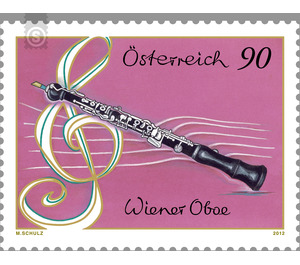Musical instruments - Austria / II. Republic of Austria 2012 - 90 Euro Cent
Theme: Art & Culture
| Country | Austria / II. Republic of Austria |
| Issue Date | 2012 |
| Face Value | 90.00 |
| Edition Issued | 250,000 |
| Printing Type | offset |
| Stamp Type | Definitive |
| Item Type | Stamp |
| Chronological Issue Number | 2321 |
| Chronological Chapter | OOS-OE2 |
| SID | 292271 |
| In 54 Wishlists | |
The continuation of the interesting brand series "Musical Instruments": The new € 0.90 value thematizes the "Wiener Oboe", a classic woodwind instrument whose earliest history dates back to antiquity. Oboes (French "Hautbois" = "high or loud wood") are usually made of grenadilla, boxwood or ebony, rare are instruments made of rosewood, rosewood or other exotic hardwood species. The approximately 65 centimeters long instrument has a conical bore and blows over into the octave, which is done by means of its own flaps. There are fully and semi-automatic oboes: In the semiautomatic, there is a lever for opening the valve for the first and second octave valve, in the fully automatic oboe there is only one lever for both octave valves, the change takes place between the notes gis and a automatically , While the fully automatic mechanism is mainly used in Germany, Poland and the Netherlands, the semi-automatic ones are mainly found in France and the USA. The sound of the oboe is expressive and sounds nasally light to dark velvety, depending on the brass school and regional tradition. From the soft tonal character of the Baroque oboe, the sound developed more and more to the more precise tone of the modern oboe, which allows a more sophisticated game, as it has more dynamic possibilities and also simplifies a fast staccato. A very special form is the "Vienna Oboe", which is played almost exclusively in Vienna, for example with the Vienna Philharmonic. It is differently mensuriert, has in the depth of a softer and in the upper position tighter, more pointed, overtone richer sound. It extends in depth in the standard form to the small h, but with a special foot piece is also the small b playable. The Viennese oboe is more similar to the baroque instrument and the classical oboe than the French oboe, both in terms of sound and playing technique. Noteworthy in the history of oboe mentioned above is that the earliest illustration of a oboe precursor from about 3000 BC. Chr. Even during antiquity there were oboe-like instruments such as the Greek Aulos or the Roman Tibia, and in the Bible, a oboe-like instrument called "Chalil" is mentioned, which was used in the temple and heard in the records throughout Jerusalem. Today the oboe finds its use in a wide variety of musical styles; Their artistic commitment ranges from classical music (chamber music, orchestra) to jazz and pop and rock music.


